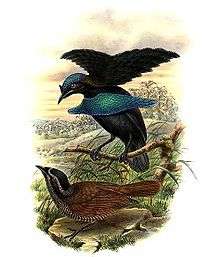Greater lophorina
| Greater lophorina | |
|---|---|
 | |
| Scientific classification | |
| Kingdom: | Animalia |
| Phylum: | Chordata |
| Class: | Aves |
| Order: | Passeriformes |
| Family: | Paradisaeidae |
| Genus: | Lophorina |
| Species: | L. superba |
| Binomial name | |
| Lophorina superba (Forster, 1781) | |
The greater lophorina or greater superb bird-of-paradise (Lophorina superba) is a species of the Paradisaeidae (bird-of-paradise) family. It was the sole species in the genus until the discovery of a second species in 2018.
Description
It is a small, approximately 26 cm long, (passerine) bird. The male is black with an iridescent green crown, blue-green breast cover and a long velvety black erectile cape covering his back. The female is a reddish-brown bird with brownish barred buff below. The young is similar to the female. The greater lophorina is a dimorphic species.[2]
Courtship display
The species has an unusually low population of females, and competition amongst males for mates is intensely fierce. This has led the species to have one of the most bizarre and elaborate courtship displays in the avian world. After carefully and meticulously preparing a "dance floor" (even scrubbing the dirt or branch smooth with leaves), the male first attracts a female with a loud call. After the curious female approaches, his folded black feather cape and blue-green breast shield springs upward and spreads widely and symmetrically around its head, instantly transforming the frontal view of the bird into a spectacular ellipse-shaped creature that rhythmically snaps its tail feathers against each other, similar to how snapping fingers work, whilst hopping in frantic circles around the female. The average female rejects 15-20 potential suitors before consenting to mate. The show that males put on to attract females can be a long process that takes up many hours in a day.[3] These species are polygynous and usually will mate with more than one female.[2]
Distribution and habitat
The greater lophorina is distributed throughout rain forests of New Guinea. It inhabits most commonly in rain forests or forest edges of Indonesia and Papua New Guinea.[4] They can also be found inhabiting mountainous habitats of the forests in New Guinea.
The greater lophorina is also usually found on top of the trees that reside in the rain forests.[5]
Food/prey
The greater lophorina travels across the trees in the forest to catch its prey which can vary depending on seasonal availability of food.[4] The greater lophorina has not only been known to eat fruits and insects, but also have been spotted preying on larger animals such as frogs, reptiles, and other small birds.[5] They can sometimes be seen foraging food on the grounds of the forest for insects.[6]
Predators
Known predators of the superb bird-of-paradise include birds of prey and snakes.[5]
Reproduction and chick behavior
The greater lophorina forms their nest on top of trees using soft material that they find around the forest such as leaves. When reproducing, they usually produce from 1-3 eggs within a nest. It takes about 16–22 days for the eggs to hatch and for the chicks to be born. After that, chicks will be able to live on their own within 16–30 days, leaving their nest and becoming independent.[6] Male superb bird's-of-paradise tend to take about two years longer for them to mature compared to the females. Also, it will take about 4–7 years for males to develop their feathers for their courtship displays.[5]
Status
Although heavily hunted for its plumes, the greater lophorina is one of the most common and widespread birds of paradise in the forests of New Guinea, and is evaluated as Least Concern on the IUCN Red List of Threatened Species.[1] It is listed on Appendix II of CITES.
Subspecies
- Lophorina superba connectens
- Lophorina superba feminina
- Lophorina superba latipennis
- Lophorina superba pseudoparotia[2]
- Lophorina superba sphinx
- Lophorina superba superba
The crescent-caped lophorina was considered to be a subspecies (L. s. niedda) until 2018, as was lesser lophorina (L. s. minor).[7]
References
- 1 2 BirdLife International (2012). "Lophorina superba". IUCN Red List of Threatened Species. Version 2013.2. International Union for Conservation of Nature. Retrieved 26 November 2013.
- 1 2 3 Coyne A., Jerry; Kay H., Emily; Pruett-Jones, Steven (August 2007). "The Genetic Basis of Sexual Dimorphism of Birds". Evolution. 62 (1): 214–219. doi:10.1111/j.1558-5646.2007.00254.x.
- ↑ "Birds of Paradise | National Geographic". 2010-04-11. Retrieved 2017-05-05.
- 1 2 "Superb bird-of-paradise videos, photos and facts - Lophorina superba". Arkive. Retrieved 2017-05-05.
- 1 2 3 4 "Bird of Paradise | San Diego Zoo Animals & Plants". animals.sandiegozoo.org. Retrieved 2017-05-05.
- 1 2 "Bird of Paradise". Animals. Retrieved 2017-05-05.
- ↑ "Distinctive Courtship Phenotype of the Vogelkop Superb Bird-of-Paradise Lophorina niedda (Mayr, 1930) Confirms New Species Status".
Further reading
- Beehler, Bruce (January 1983). "Frugivory and Polygamy in Birds of Paradise". The Auk. 100 (1): 1–12. ISSN 0004-8038.
- Coyne A., Jerry; Kay H., Emily; Pruett-Jones, Steven (August 2007). "The Genetic Basis of Sexual Dimorphism in Birds". Evolution. 62 (1): 214–219. doi:10.1111/j.1558-5646.2007.00254.x.
- Donovan, T. A.; Schrenzel, M.; Tucker, T. A.; Pessier, A. P.; Stalis, I. H. (1 May 2008). "Hepatic Hemorrhage, Hemocoelom, and Sudden Death due to Haemoproteus Infection in Passerine Birds: Eleven Cases". Journal of Veterinary Diagnostic Investigation. 20 (3): 304–313. doi:10.1177/104063870802000307. PMID 18460616.
- Frith, D.W.; Frith, C.B. (1988). "Courtship Display and Mating of the Superb Bird of Paradise Lophorina superba". Emu. 88 (3): 183–188. doi:10.1071/MU9880183.
External links
| Wikimedia Commons has media related to Lophorina superba. |
| Wikispecies has information related to Lophorina superba |
- Superb Bird-of-Paradise Video by the Cornell Lab of Ornithology
- BirdLife Species Factsheet
- Video on YouTube
